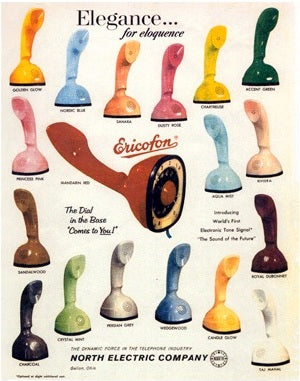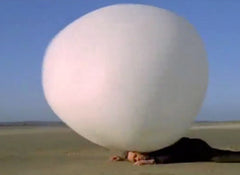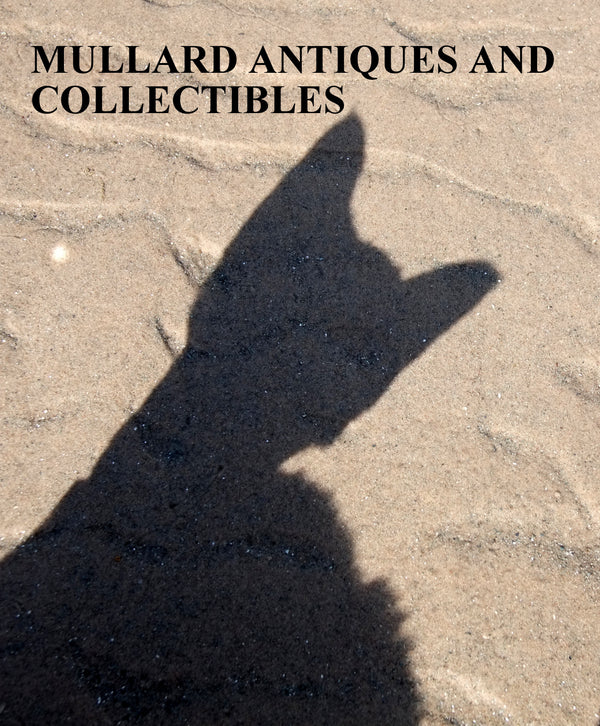
A 1960’s/ 70’s Design Classic? The Ericofon Cobra Phone
A 1960’s/ 70’s Design Classic? The Ericofon Cobra Phone
Love it or hate it, the iconic design of the Ericofon Cobra phone is a must for any 1950’s-1970’s retro or vintage office, music room or living room! It is called a ‘Cobra’ or ‘Kobra’ due to its snake-like appearance. The Ericofon has a bit of a cult following amongst fans of 1960’s and 70’s fashion and design. Here’s why.
Design:
The Ericofon is a one-piece plastic telephone made by the LM Ericsson Company, Sweden. It was manufactured from the 1950’s until the 1970’s. It was available to special order into the 1980’s in the form of the British Telecom BT model 021. This model was only available in an orange or white finish.

Ericofon 600 British Telecom Ericofon
The Ericofon is the first commercially marketed telephone to incorporate the dial, handset, ringer, receiver and speaker into a single lightweight unit. However, as early as 1929 there had been other innovative phone designs, including the ‘Siemens Ham Bone’ or ‘ Squatting Dog.’

Siemens Hambone Modell 29 ‘Hockender Hund’
In this early design, the housing and receiver are fused, and the unit is made of black Bakelite with contrasting white dial. The striking design of the phone, which officially bore the name “Model 29”, led to the nickname of “Crouching or Squatting dog” or “ham bone”.
Fans of the surreal 1960’s British TV programme ‘The Prisoner’ No.6 starring Patrick McGoohan:
‘I am not a number! I am a free man’
may also remember the single unit handsets used by No.2.

Phones used by No. 2 in ‘The Prisoner
The Prisoner starring Patrick McGoohan
(Thanks to my other half for that ‘interesting’ fact. I confess that I don’t understand ‘The Prisoner’. The sight of grown adults dressed in blazers and straw boaters, playing with an over large beach ball called 'Rover'on the beautiful beach at Portmeirion, North Wales, makes me shake my head in bewilderment!)

The beach ball 'Rover' from 'The Prisoner'
Anyway….
Some More Interesting Facts:
WWII led to the development of several new lighter weight materials and ferromagnetic electronics, which were quickly put to peacetime use by many industries leading to massive changes in design and technology. Ericsson were no different; they wanted a smaller, lightweight, and easier to use phone.

The design team, headed by H G (Gosta) Thames came up with the basic design of the ‘Cobra phone’. After several prototypes, a design was agreed and stayed in production for the next two decades. Its sleek and ergonomic design looks just as good today as when it was first sold!
Interestingly, when the Ericofon first came into use in 1954, it was intended for institutional use, and its best customers were hospitals. Patients found the lightweight phone easy to use from their beds rather than the huge metal or Bakelite desk phones that were available pre-war and, usually, only found in the Sister’s office. Since long spells convalescing were rigorously enforced in those days, you would have been very lucky to have been able to leave your bed to use a phone!
Colours

Orange Ericofon 600 British Telecom

Accent Green Ericofon from www.ericofon.com
The phone was originally available in 18 fabulous colours (see the advert in the featured image). The most popular colours were Red and Ivory. Many of these different coloured phones are becoming increasingly rare to find. According to the very knowledgeable Richard Rose of Ericofon.com, ‘Accent Green’, withdrawn from the North American market in the 1960’s, is amongst the rarest.
In 1973, the Ericofon Cobra telephone exhibited in the ‘Museum of Modern Art’ (MoMA) in New York, and it’s considered one of the most significant industrial designs of the 20th century.
In Mad Men (2007-2012), Roger Sterling uses an Ericofon in his new office.
How to Use The Phone!
I asked my 11-year-old nephew to dial a number for me with the Ericofon. He was totally perplexed so, for those of you who are too young to remember analogue dial phones:
- You have to press the big red button in the centre of the base until you hear a dial tone, and then
- You dial your number using your right or left index finger whilst holding the phone in the other hand.
- Remember to move the dial clockwise as far as it will go whilst your finger is on the number, and then
- Release the dial between dialling each of the numbers to allow it to return to zero…
Hope that makes sense…
Have a look at the Mullard Antiques Shop for more quirky vintage technology!
